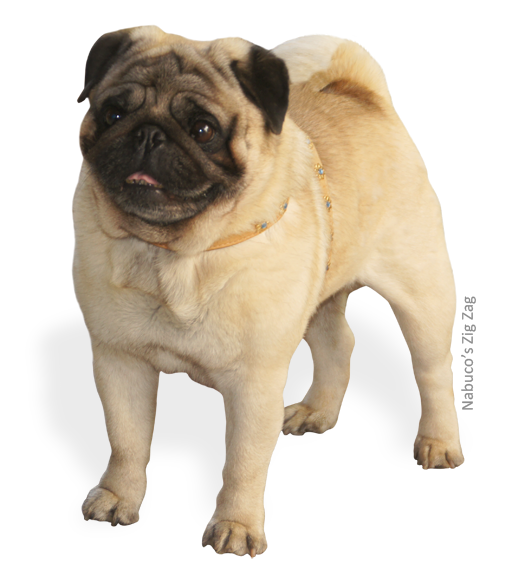ABOUT THE PUG
Pugs are primarly indoor company pets, whose joy is to be near people. Their very purpose is to amuse humans. When playing, they aim at enchanting people, which they achieve with great success.
A pug generally becomes the owner of the house, and although he elects his favorite human, and follows him everywhere like a shadow, he loves everyone, including the children.
We generally inquire people who come to us asking for a puppy, whether they are prepared to own a pug. This means meeting the pug’s expectation to be lavishly loved, not to be left alone during a whole working day, not to be raised in a backyard, away from direct contact with humans, and specially not to be isolated in a kennel. Some of them may become ill in a situation like that.
Acquiring your pug means a commitment to brushing his fur daily, to avoid your couch from becoming full of it, but nevertheless tolerate some fur around the house; to cleaning his wrinkle around the nose at least twice a week; to protect him from smaller children games, as falls may injure the heavy pug; to frequently checking his eyes that are prone to being hurt, due to the absence of a muzzle to protect them from trauma; to being amused by his constant snoring; to avoiding taking him out on a very hot day, keeping him in a cool and ventilated place; to never leaving him locked inside a car while you go shopping (you might not find him alive due to the heat and stress); to never making hard walks, and much less jogging with him.
Acquiring a pug is like acquiring a new family member, and being sure that you are receiving a great buddy, a very special dog. We commonly say that one hasn’t lived, until has been owned by a pug!
ABOUT BREEDING
The pug has become a popular breed, and whenever it happens, many people want to breed. However, breeding pugs can be significantly burdensome and costly, thus frustrating a profit expectation.
Many pug bitches require caesarian sections, which may sometimes bring complications and even lead to death, when they are not timely helped by a Vet well experienced with pugs, and particularly skilled in the difficult art of safely anesthetizing them. Few pug bitches are good mothers, and the survival of the litter, which is significantly frail, will depend on the breeder: the puppies must be kept warm and can not stay together with their mums unsupervised, at least until they open their eyes (sometimes longer), owing to the risk that the mother lies down on the puppy.
The breeder must take the puppies to the mother to suckle, and to evacuate, every 2 hours round the clock until they are at least 15-day old. Then the intervals between the breastfeeding sections may be increased until the puppies are ready to begin their weaning, at the age of 45 days.
It is the breeder’s responsibility to place all of the puppies in good loving homes. The future owners must be made aware of the peculiar characteristics and physical and emotional needs of this very special breed, and the responsible breeder must be prepared to undertake to buy back or to re-place any puppies for his kennel that may no longer stay with their owners for whatever reason.
A female pug should not have more than 4 litters, even in case of normal delivery, as breeding and breastfeeding represent an overload. We normally spay our bitches at the age of 6.
Anyone willing to become a breeder, should choose healthy pugs purchased from reliable breeders. Even when they are no longer capable of breeding, they must remain with their breeder-owners, being looked after and caressed throughout their lives.
(Adapted from “Breeding or Spaying/Neutering”, from The Pug Dog Club of America Website)
ABOUT SPAYING/NEUTERING
We must bear in mind that breeding is not a female Pug’s need, as commonly believed. Spayed females live longer and healthier lives. The likelihood of developing cancer is substantially reduced after the spaying, which also eliminates the inconvenience of the heat for those not intended to breed.
Neutering is also recommendable for males intended for company only, and for those no longer is the breeding program. Neutered males no longer face the risk of testicular cancer, and are less prone to prostate problems.
Spayed females and neutered males do not become fat or slow. This is attributable to an inadequate feeding and to the lack of exercise. Some people wrongly see the spaying/neutering as an aggression to the dog, but they surely ignore the benefits deriving from spaying a female or neutering a male not intended to reproduction.
Assuring a good and healthy life to our Pugs should be our goal, as a reward to those who make our lives so much happier!
(Adapted from Breeding or Spaying/Neutering, from The Pug Dog Club of America Website)

